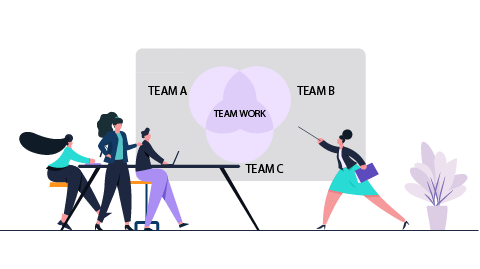Cross-Functional Teams: A Brief Guide
According to BusinessDictionary, cross-functional teams are:
"A group of people with different functional specialties or skill sets, responsible for carrying out all phases of a program from start to finish."
The functional areas of people in cross-functional teams can have diverse ranges. When a group of people from different backgrounds, like the marketing, sales, or product teams, come together to achieve a common goal, it creates a cross-functional team.
CFTs can exist as a central part of organizational structure or as an addition to the company's main hierarchy.
In this article, we'll look at why developing cross-functional teams is beneficial.
An Example of Cross-Functional Collaboration
Suppose there's a problem with your phone. To resolve it, you place a call to your mobile service's support team.
Instead of getting the issue resolved, the support team transfers the call from one department to another, thus delaying the problem.
Tiresome, right? That is where a cross-functional team would help to mitigate the problem.
CFTs represent a group of people with diverse skills who form a high performing team and work towards a common goal. In this case, it's solving the customer's issue and building a long-lasting relationship with them.
Remote Cross-Functional Teams: The Need Of The Hour?
The COVID pandemic has bought about a sudden shift to the standard work arrangements. Even the usually effective project managers and teams are facing the brunt of it.
Problem-solving has quickly become a primary skillset. The hour's need is to have a group of people from different teams in a single task force to get things done.
By including people from diverse backgrounds with a common goal, achieving tasks becomes faster. Such teams work and play by their strengths to put the most feasible solution forward in real-time.
Producing a cross-functional project with a remote team can give you an edge over others. Thus, it's essential to understand the dynamics of managing such cross-functional collaboration.
Recommended Article: Work From Home Policy
The Benefits Of Cross-Functional Teams
When different teams collaborate, efficiency increases, productivity rises, and peer relationships developes.
Here are a few more benefits that make clear the need for having CFTs in an organization.
Benefit 1: Pushes Organizational Boundaries

CFTs transcends usual functional boundaries. They go beyond organizational structures, ensuring that skilled employees from different teams collaborate to work cohesively.
CFTs bring a group of people closer and enable them to understand each other's viewpoints. That promotes a work environment where there's a constant exchange of ideas and information.
Building CFTs means to divert the negative mentality where particular divisions of a company refuse to share information with other teams.
Recommended Article: Importance Of Teamwork
Benefit 2: Reduces Cycle Time

BusinessDictionary defines cycle time as "the period required to complete one cycle of a project from start to finish."
Cycle time is the duration between a customer's demand for a service and the delivery time. The longer it takes for the assigned team to deliver the outcome, the more the relationship between the customer and the company degrades.
Over a while, this can also negatively affect the company's bottom line.
But, when skilled people work together, problem-solving becomes easier and faster.
A group of people can define their area expertise and divide the tasks accordingly. After area allocation and defining purpose, teams collaborate to get the job done.
Recommended Article: How Employee Satisfaction Can Lead To Customer Satisfaction
Benefit 3: Thorough Decision Making

Working in a team is about making collective decisions and arriving at a consensus together.
Teamwork can help drive effective decision making. When teams work together, they come up with numerous alternatives to a problem than when working alone. And they generate these problem-solving alternatives together.
Decision making becomes faster when working in a cross-functional team.
In a CFT, you have a group of people from marketing, sales, and operations working in the same team. Thus, a problem in the cross-functional project gets seen through various viewpoints. Sales team, product team, development team- everyone pitches in. Having a variety of perspectives makes the problem easier to solve.
That ensures that no aspect of a problem gets unnoticed. Also, effective teams know a situation can affect each department, they try to develop a solution that benefits the customer and the entire business.
Recommended Article: Decision Fatigue
Benefit 4. Offers a Fresh Perspective

Working alone can become monotonous. However, working with a team with the same area of expertise can be boring too. To look at things from a fresh perspective, you need people with diverse skill sets.
Cross-functional teams fit perfectly into this equation.
A group of people with diverse professional expertise can develop new ideas that others might have overlooked. They can also perceive a problem or flaw with the solution that went unnoticed.
Recommended Article: Creativity At Work
Benefit 5. Brings Peers Closer

When teams collaborate, they sometimes agree or disagree with each other's decisions. But it definitely brings them closer. Working together enables a group of people to let go of any former judgments they might have formed of each other.
Team collaboration lets people see how their team members arrive at a conclusion and their thought process. It makes them more understanding and accepting of each other.
Recommended Article: Role of Healthy Peer Relationships
Benefit 6. Regulates Internal Communication

For teams to be successful, they need to know what every team member is upto. It is possible only when groups communicate amongst themselves internally.
Communicating effectively enables people to learn skills and strategies from their team members. An effective team who communicates well, frequently discuss new ideas. Such teams work to understand what's best for everyone and how they can effectively fulfill their individual roles.
Recommended Article: Cross-Functional Communication Best Practices to Boost Collaboration
But 75 Percent of Cross-Functional Teams Are Dysfunctional
Wait. What?
Yes, the subject matter experts do seem to think so. A 2015 survey by Harvard Business Review found that dysfunction is common in CFTs.
75% of cross-functional teams are dysfunctional on at least 3 of these 5 categories:
- Meeting a planned budget.
- Staying on schedule.
- Adhering to specifications.
- Meeting customer expectations.
- Maintaining alignment with the company's organizational goals.
But it's 2024 now, and management skills have improved a lot since then. Now that you know the problems, you can focus on fixing them first.
7 Tips On How To Develop Cross-Functional Teams
To avoid the drawbacks stated above and deflect other such similar problems, developing a skilled cross-functional team is essential. Here are some key points to remember while building such a team:
1. Assemble Effective Teams

It is the starting point. How your team functions will depend on the kind of team, they are. Most importantly, you need to recognize if the employees will play on each other's strengths.
After deciding the project's common goal, figure out which employees can help in achieving the target. Here human resources can help you recognize employees who will fulfill your requirements.
2. Define Clear Roles And Objectives

Setting down goals and objectives is an excellent step for creating a cross-functional team. Clear objectives improve collaboration, communication, and help the business grow. It also helps everyone understand where the company is heading.
When you set a common goal and delegate tasks, team members know what's expected of them. It enables them to strategize and divide tasks among themselves easily. Managers and teams can conduct a SWOT analysis to figure out individual strengths and how to overcome their weaknesses.
Having SMART organizational goals can be used expertly by skilled cross-functional team members. It can make dividing and following responsibilities easy.
- S- Specific
- M- Measurable
- A- Achievable
- R- Relevant
- T- Timely
3. Involve The Customer

To ensure smooth execution of the cross-functional project, it is necessary to sync with the common goal. That is where involving the customer comes in handy.
Customer interaction allows teams to be clear about the outcome expected from them. They can then proceed accordingly.
Sometimes, the team leader assigns a team member to represent them and interact with the customer. These people update the customers at regular intervals and take their feedback. Doing so creates clarity and sync between the customer and the team.
4. Embrace Diversity and Inclusion

Cross-functional teams give you the power to select people from really diverse backgrounds.
You can include team members from various backgrounds like gender, ethnicities, and professional expertise. Multiple research has shown that diverse teams are more effective in processing information. They provide fresh ideas and quick solutions.
Once you've assembled a diverse team, it is equally essential to make this team feel important and included.
If team members feel they are not as valuable as others, they might feel left out. It can cause the team to lose out on a skilled employee and increase the cycle time. To avoid this, treat everyone equally and fairly. Everyone should be allowed to express their views and opinions.
5. Share Accountability For Organizational Goals

A successful team understands that they're achieving for the team and not try to be the best of the group. These teams can only successfully function when they know that each team member is responsible for others' actions.
Responsibilities need to be shared equally among employees. They should progress with the mentality that the whole team will be held accountable depending on the cross-functional project’s outcome. It will lead to them helping each other out to achieve their respective targets.
With shared accountability also comes shared recognition. When cross-functional teams deliver outcomes, success is shared among each employee. Every team member is acknowledged and appreciated for their contribution.
6. Cross-Functional Project Management Tools

With the advent of technology and AI in business, HR is soon transforming into HR-Tech. Online tools for recruitment, communication, and project management are all the rage now.
Project management tools are a useful commodity while managing cross-functional teams. Project management tools aids help to keep the tasks on track and in sync. Such tools keep track of time, budget, and expenses required in cross-functional projects.
7. Establish Metrics

Measurement makes room for progress and improvement. When you assess an idea, you can recognize the pros and cons of that thought. You can identify the problems and the consequences they might have. Thus, it is essential to reevaluate regularly.
Another way to use metrics is to measure employees' performance and their progress.
Metrics like time management tools are extremely helpful. They track the time and effort required to complete the cross-functional projects.
Measuring can also help realize if the employees lack somewhere. Doing this can allow employees to track progress and take up training sessions to upskill.
Finally
Do the benefits of cross-functional teams seem feasible to you in the long run? Do drop us a mail and share your thoughts with us!
















